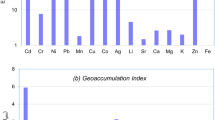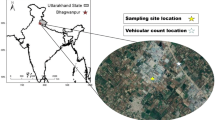Abstract
Atmospheric particulate matters in nine size fractions were sampled at Huangshi city, Hubei province. Elemental concentrations occurred unimodal size distribution for Zn, Pb and Ni, dimodal distribution for Ca, S, Fe and Ti, and trimodal distribution for Cl, K, Mn, Cu and Cr. Enrichment factor and principal component analysis identified the main sources from crustal material, biomass burning, waste incineration, vehicular and industrial emission. As for the non-carcinogenic health risk through inhalation, there were certain potential risks for Mn and Sb for children, and Pb for children and adults in PM2.5. It showed certain potential risks for Mn, Sb and Pb for children and adults in PM10. As for the carcinogenic health risk through inhalation, Cr in PM2.5 and Ni, Co and Cr in PM10 indicated unacceptable risk for children and adults. Meanwhile, Co and Ni in PM2.5 represented acceptable risk for children.




Similar content being viewed by others
References
Allen AG, Nemitz E, Shi JP et al (2001) Size distributions of trace metals in atmospheric aerosols in the United Kingdom. Atmos Environ 35(27):4581–4591
Cao JJ, Xu HM, Xu Q et al (2012) Fine particulate matter constituents and cardiopulmonary mortality in a heavily polluted Chinese city. Environ Health Persp 120(3):373–378
Cheng MT, Chou WC, Chio CP et al (2008) Compositions and source apportionments of atmospheric aerosol during Asian dust storm and local pollution in central Taiwan. J Atmos Chem 61:155–173
Cong ZY, Kang SC, Dong SP et al (2010) Elemental and individual particle analysis of atmospheric aerosols from high Himalayas. Environ Monit Assess 160:323–335
Cui LM, Wu ZN, Han P et al (2020) Chemical content and source apportionment of 36 heavy metal analysis and health risk assessment in aerosol of Beijing. Environ Sci Pollut R 27:7005–7014
Đorđević D, Stortini AM, Relić D et al (2014) Trace elements in size-segregated urban aerosol in relation to the anthropogenic emission sources and the resuspension. Environ Sci Pollut Res 21:10949–10959
Duan J, Tan J (2013) Atmospheric heavy metals and arsenic in China:situation, sources and control policies. Atmos Environ 74:93–101
Fang DQ, Huang W, Antkiewicz SD et al (2019) Chemical composition and health risk indices associated with size-resolved particulate matter in Pearl River Delta (PRD) region, China. Environ Sci Pollut R 26:12435–12445
Fang GC, Wu YS, Huang SH et al (2005) Review of atmospheric metallic elements in Asia during 2000–2004. Atmos Environ 39(17):3003–3013
Feng JL, Yu H, Liu SH et al (2017) PM2.5 levels, chemical composition and health risk assessment in Xinxiang, a seriously air-polluted city in North China. Environ Geochem Health 39:1071–1083
Gao Y, Guo XY, Li C et al (2015) Characteristics of PM2.5 in Miyun, the northeastern suburb of Beijing: chemical composition and evaluation of health risk. Environ Sci Pollut Res 22:16688–16699
Gautam S, Patra AK, Kumar P (2019) Status and chemical characteristics of ambient PM2.5 pollutions in China: a review. Environ Dev Sustain 21:1649–1674
Han YJ, Kim SR, Jung JH (2011) Long-term measurements of atmospheric PM2.5 and its chemical composition in rural Korea. J Atmos Chem 68(4):281–298
Hu TP, Zhang JQ, Xing XL et al (2018) Seasonal variation and health risk assessment of atmospheric PM2.5-bound polycyclic aromatic hydrocarbons in a classic agglomeration industrial city central China. Air Qual Atmos Hlth 11(6):683–694
Kar S, Maity JP, Samal AC et al (2010) Metallic components of traffic-induced urban aerosol, their spatial variation, and source apportionment. Environ Monit Assess 168:561–574
Kim KH, Kabir E, Kabir S (2015) A review on the human health impact of airborne particulate matter. Environ Int 74:136–143
Kuzu SL, Saral A, Demir S et al (2013) A detailed investigation of ambient aerosol composition and size distribution in an urban atmosphere. Environ Sci Pollut Res 20(4):2556–2568
Lee K, Hur Do S, Hou SG et al (2008) Atmospheric pollution for trace elements in the remote high-altitude atmosphere in central Asia as recorded in snow from Mt. Qomolangma (Everest) of the Himalayas. Sci Total Environ 404(1):171–181
Lee PK, Jo HY, Kang MJ et al (2015) Seasonal variation in trace element concentrations and Pb isotopic composition of airborne particulates during Asian dust and non-Asian dust periods in Daejeon, Korea. Environ Earth Sci 74:3613–3628
Li L, Wang QY, Zhang X et al (2019) Characteristics of single atmospheric particles in a heavily polluted urban area of China: size distributions and mixing states. Environ Sci Pollut Res 26:11730–11742
Liu HX, Kawamura K, Kunwar B et al (2019) Dicarboxylic acids and related compounds in fine particulate matter aerosols in Huangshi, central China. J Air Waste Manag 69(4):513–526
Liu HX, Kawamura K, Kunwar B et al (2017) Sources and formation processes of short-chain saturated diacids (C2–C4) in inhalable particles (PM10) from Huangshi city, central China. Atmosphere 8:213
Liu HX, Zheng JR, Qu CK et al (2017) Characteristics and source analysis of water-soluble inorganic ions in PM10 in a typical mining city, Central China. Atmosphere 8:748
Lyu Y, Zhang K, Chai FH et al (2017) Atmospheric size-resolved trace elements in a city affected by non-ferrous metal smelting: indications of respiratory deposition and health risk. Environ Pollut 224:559–571
Men C, Liu RM, Xu F et al (2018) Pollution characteristics, risk assessment, and source apportionment of heavy metals in road dust in Beijing, China. Sci Total Environ 612:138–147
Ny MT, Lee BK (2011) Size distribution of airborne particulate matter and associated metallic elements in an urban area of an industrial city in Korea. Aerosol Air Qual Res 11:643–653
Okuda T, Tenmoku M, Kato J et al (2006) Long-term observation of trace metal concentration in aerosols at a remote island, Rishiri, Japan by using inductively coupled plasma mass spectrometry equipped with laser ablation. Water Air Soil Pollut 174:3–17
Onat B, Alver SU, Bayat C (2012) Assessment of particulate matter in the urban atmosphere: size distribution, metal composition and source characterization using principal component analysis. J Environ Monit 14(5):1400
Park K, Dam HD (2010) Characterization of metal aerosols in PM10 from urban, industrial, and Asian Dust sources. Environ Monit Assess 160:289–300
Slezakova K, Pires JCM, Pereira MC et al (2008) Influence of traffic emissions on the composition of atmospheric particles of different sizes-Part 2: SEM–EDS characterization. J Atmos Chem 60(3):221–236
Srivastava A, Jain VK (2007) Size distribution and source identification of total suspended particulate matter and associated heavy metals in the urban atmosphere of Delhi. Chemosphere 68(3):579–589
Sun YY, Hu X, Wu JC et al (2014) Fractionation and health risks of atmospheric particle-bound As and heavy metals in summer and winter. Sci Total Environ 493:487–494
Raman RS, Hopke PK, Holsen TM (2008) Characterization of fine aerosol and its inorganic components at two rural locations in New York State. Environ Monit Assess 144(1–3):351–366
U S EPA (2009) Risk assessment guidance for superfund volume I: human health evaluation manual (Part F)
Wei X, Gao B, Wang P et al (2015) Pollution characteristics and health risk assessment of heavy metals in street dusts from different functional areas in Beijing, China. Ecotoxicol Environ Saf 112:186–192
Xu LL, Chen XQ, Chen JS et al (2012) Seasonal variations and chemical compositions of PM2.5 aerosol in the urban area of Fuzhou. China Atmos Res 104–105:264–272
Yang J, Fu Q, Guo XS et al (2015) Concentrations and seasonal variation of ambient PM2.5 and associated metals at a typical residential Area in Beijing, China. Bull Environ Contam Toxicol 94:232–239
Zhan CL, Zhang JQ, Zheng JR et al (2019) Characterization of carbonaceous fractions in PM2.5 and PM10 over a typical industrial city in central China. Environ Sci Pollut Res 26(17):16855–16867
Zhang H (2009) An assessment of heavy metals contributed by industry in urban atmosphere from Nanjing, China. Environ Monit Assess 154:451–458
Zhang NN, Guan Y, Yu L et al (2019) Spatio-temporal distribution and chemical composition of PM2.5 in Changsha. China. J Atmos Chem 77:1–16
Zhang Q, Jiang XJ, Tong D et al (2017) Transboundary health impacts of transported global air pollution and international trade. Nature 543(7647):705–709
Zhang RJ, Xu YF, Han ZW (2004) A comparison analysis of chemical composition of aerosols in the dust and non-dust periods in Beijing. Adv Atmos Sci 21(2):300–305
Zhang XY, Li ZQ, Takeuchi N et al (2017) Heavy metal-polluted aerosols collected at a rural site, northwest China. J Earth Sci 28(3):535–544
Zhao Y, Feng LH, Shang BD et al (2019) Pollution characterization and source apportionment of day and night PM2.5 samples in urban and suburban communities of Tianjin (China). Arch Environ Con Tox 76:591–604
Zheng JR, Zhan CL, Yao RZ et al (2018) Levels, sources, markers and health risks of heavy metals in PM2.5 over a typical mining and metallurgical city of central China. Aerosol Sci Eng 2(1):1–10
Acknowledgement
This work was supported by National Key R&D Program of China (2017YFC0212602), University Student Innovation and Entrepreneurship Training Programs of Hubei province (S201910920065), Open Foundation of Mine Environmental Pollution Control and Remediation of Hubei Key Laboratory (2016103). We gratefully thank Dr. Ying Hu and Dr. Bhagawati Kunwar for polishing the language.
Author information
Authors and Affiliations
Corresponding author
Rights and permissions
About this article
Cite this article
Zhou, W., Liu, H., Xiang, J. et al. Assessment of Elemental Components in Atmospheric Particulate Matter from a Typical Mining City, Central China: Size Distribution, Source Characterization and Health Risk. Bull Environ Contam Toxicol 105, 941–950 (2020). https://doi.org/10.1007/s00128-020-03039-w
Received:
Accepted:
Published:
Issue Date:
DOI: https://doi.org/10.1007/s00128-020-03039-w




